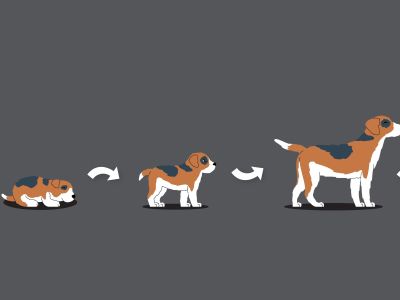For any paw parent, the puppies are just like their own baby. The way they excitedly wait for their own children to walk is the same way they do for puppies. This is when the question, “When do puppies start walking?” pops into their mind.
Here through our blog, we will provide you with the equipped information about when your puppy will start walking. We will also try to be diverse with the information regarding the mobility problems in puppies.

Why Is It Important To Know When Puppies Start Walking?
Here are the reasons why it is important to know when puppies start walking:
- It is an indication of the puppy’s health. It helps to identify if your puppy has any mobility issues[1] or not. If you have an idea of the general time period puppies start walking then you can track their growth.
- By knowing the right walking age of puppies you can be prepared. If you know when the puppies start walking you can create a safe and protective environment for them.
- Knowing the time when your puppy will start walking can help you to be prepared for the leash training process. You can be prepared with the various tips and techniques.
- It will help you bond with your puppy. Knowing details about your puppy’s growth will help you understand their growth and behaviour. This will contribute to your bonding and building an understandable relationship with them.
When Do Puppies Start Walking?
When we talk about walking, when human babies are born they do not start walking straight up they do it gradually. First, they develop a sense, they learn to move their legs, crawl and then slowly slowly learn to walk and run. This happens with the puppies too.
The puppies when born have not developed all the senses this process takes time. So here is the explanation of how at different ages[2] the puppy’s body grows and he learns to walk:

Newborn stage (0 to 2 weeks)
The 0 to 2 weeks of age is considered to be the newborn stage of the puppies. Puppies are already born with the sense of taste and touch and they can even crawl to some extent.
During the period of 0 to 2 weeks, the muscles of the dog start to grow and become stronger. These growing muscles help puppies crawl.
Transitional Stage (2-3 weeks)
Between the period of 2 to 3 weeks, the puppy starts to stand and walk slowly. During this period the puppy becomes playful and curious and starts to explore the surroundings.
Socialization Stage (3-8 weeks)
The period of 3 to 8 weeks in puppies is considered as the socializing stage. In this period the puppies start to interact, communicate and learn new skills. The puppy starts walking and running completely.
As mentioned by Autumn Madden, DVM in petmd, "The critical time for socialization to begin is 3 weeks old, and the socialization window closes around 12-14 weeks of age. If socialization is not done during this period, your puppy may react fearfully to unfamiliar situations such as new people, places, or objects."
Leash Training Stage (8 weeks and beyond)
By the 8th week, you will notice your puppy running from here and there. During this period the dog’s muscles have grown strong and he is ready to be taken outdoors.
With curiosity at its peak and rapid running speed, dogs during this age are nothing but creatures of naughtiness. Thus they require leash training. Leash training helps to control your almost uncontrollable puppy easily.
How To Spot Puppy Mobility Problems?
The mobility issues in puppies are serious as they can affect their lifestyle. Knowing the actual walking period in dogs helps to deal with and identify these issues and treat them. Some of these mobility issues are genetic and require extra care and comfort.

Here are the symptoms to spot puppy mobility problems:
- Muscle loss and weakness: In this condition, the puppy’s ability to stand, walk and move is affected due to congenital deformities, infection or due to some diseases.
- Bunny hopping: In this condition, the puppy runs and jumps with both hind legs held together. Though this may not seem to be a problem, in fact, it is an indication of conditions like floating kneecaps and hip dysplasia.
- Pain and discomfort: If your puppy is experiencing pain and discomfort while moving around then consult a vet immediately. This pain and discomfort can be either due to injury or due to health issues.
- Limping: if your puppy is limping while walking then take him to the vet immediately and identify its cause. This limping on dogs can affect their quality of life.
- Clicking or popping sound: The clicking and popping sound in dogs while moving or running can be a sign that there is something wrong with your dog’s mobility. This should not be taken lightly and should be addressed soon.
These are some common symptoms easy to observe in your puppy. If your puppy has surpassed the the age period of 2 to 4 weeks and still not walking then you should get them medically diagnosed. This will help you help your puppy.
FAQs
When do puppies start walking?
The walking of puppies depends on factors like their breed and size. The development periods of puppies are different from one another. By 2 to 4 weeks the puppies start crawling and by 4 to 8 weeks of age period they start walking completely.
At what age do puppies walk properly?
The walking period in puppies may differ in dogs some might start walking early while a few of them may take time. The walking time of puppies depends widely on their growth and development. Generally, the puppies start to walk completely by the age of 4 to 8 weeks.
How often should I walk my puppy?
The walking time of puppies depends on their age. In the beginning, the walking of puppies should be less till they get completely comfortable with it. For the puppies, you should start the walk by 5 minutes twice a day and with each passing month increase the time period by 5 minutes.
How to deal with common walking problems with my puppy?
Making puppies walk won’t be an easy task to accomplish. The tantrums the puppies throw might be unbearable but they can be controlled. To avoid the walking problem in your puppy, train him. Training the puppy as early as possible will make the puppy listen to your commands during a walk.
How to prepare my puppy for a long walk?
Before taking the puppy to a long walk you should start by introducing small distance walks. Don’t increase the distance instantly begin by increasing the distance gradually. Vaccinating the puppy, this step is very necessary in order to take your puppy out for a walk. Vaccination protects your young disease-prone puppies from all the fatal effects of the diseases.
Conclusion
The excitement to see your puppy walk and enjoy that entire process is delightful for the paw parents. But this delightful sight comes with a lot of preparation and stress. The main concern of paw parent is when their fur baby will walk, we hope that through our blog, “When do puppies start walking?” this concern is addressed.
There are many times when the walking period varies in puppies so be patient. In some cases, the puppies do face mobility issues and are abandoned due to this reason. If this happens with your puppy then like a responsible paw parent take care of them and if not possible send them to a good shelter home where they can be taken care of.
Reference:
- Pain and mobility issues in pets – Oklahoma State University. (2018, November 1).
- Mmyers. (2023, May 19). The Puppy Timeline: Physical and Mental Changes | VMBS News. VMBS News.



